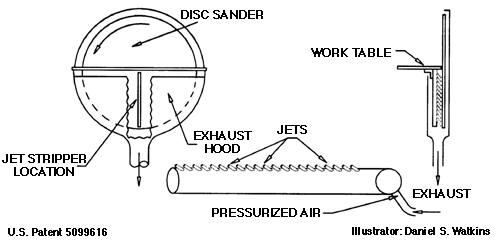Control of Wood Dust From Large Diameter Disc Sanders
1996
DHHS (NIOSH) Publication Number 96-124
Hazard
The use of large diameter disc sanders creates significant amounts of wood dust. Workers exposed to wood dusts have experienced a variety of adverse health effects such as eye and skin irritation, allergy, reduced lung function, asthma, and nasal cancer. Therefore, the National Institute for Occupational Safety and Health* (NIOSH) recommends limiting wood dust exposures to prevent these health problems.
Controls
Surveys by NIOSH researchers found that wood dust created by large diameter disc sanders is often not effectively controlled. To address this problem, researchers designed a ventilation control system that significantly reduced wood dust emissions into the workroom.
Jet Stripper System
The standard dust control arrangement for disc sanders usually consists of an exhaust hood under the worktable that covers the lower half of the disc and a cover around the back of the sanding disc above the worktable. Even with this control, significant amounts of wood dust are emitted into the workroom. A Jet Stripper System was designed to improve dust control. (See ILLUSTRATION) The Jet Stripper supplies pressurized air to the disc inside the hood. The jet of high speed air blows the dust particles out of the disc air layer so they can be captured by the exhaust hood. Also, the jet removes the dust particles embedded in the sanding disc. The Jet Stripper System reduced wood dust emissions by an average of 60 percent in laboratory studies. The advantages of this control are that it does not interfere with the operator, requires minimal maintenance and is inexpensive to operate. The Jet Stripper may also extend the life of the sanding discs by dislodging the wood dust from the sanding surface. This dust control device is not currently commercially available. Call NIOSH for more information.
*NIOSH is the Federal agency responsible for conducting research and making recommendations for preventing work-related illness and injuries. HAZARD CONTROLS are based on research studies that show reduced worker exposure to hazardous agents or activities.
Illustration: DISC Sander with Jet Stripper Installed in Exhaust Hood

A technical article Control of Wood Dust from Disc Sanders, Appl Occup Environ Hyg 6(11):938 944(1991), has been published on this subject. Also, a videotape New Ventilation System for Disc Sanders, Tape #206, 4 minutes, may be borrowed free of charge.
This document is one in a series of seven HAZARD CONTROLS concerning wood dust control techniques listed below that are available free upon request from NIOSH:
- HC4 Control of Wood Dust from Horizontal Belt Sanders
- HC5 Control of Wood Dust from Shapers
- HC6 Control of Wood Dust from Automated Routers
- HC7 Control of Wood Dust from Large Diameter Disc Sanders
- HC8 Control of Wood Dust from Random Orbital Hand Sanders
- HC9 Control of Wood Dust from Orbital Hand Sanders
- HC10 Control of Wood Dust from Table Saws
Acknowledgments
The principal contributors to this HAZARD CONTROLS are Jennifer L. Topmiller, Division of Physical Sciences and Engineering, and Jerome P. Flesch, Education and Information Division, NIOSH.
This document is in the public domain and may be freely copied or reprinted. NIOSH encourages all readers of this HAZARD CONTROLS to make it available to all interested employers and workers.
Control of Wood Dust From Large Diameter Disc Sanders [PDF – 164 KB]
